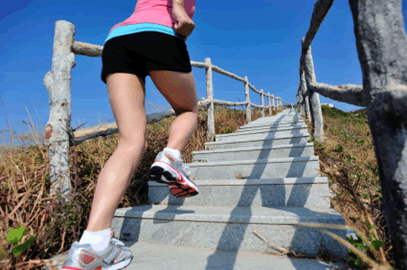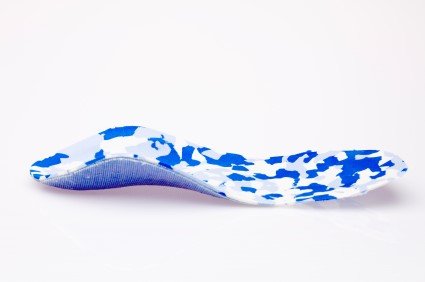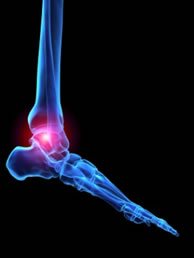December 2016
Running Offers Both Benefits and Risks
 Running is a great exercise for our body, as it improves our cardiovascular health, increases our metabolism and can build up our muscles. However, running also poses a risk of injury, especially if you engage in running as a strenuous exercise. Protect your feet before running by stretching before and after, as this improves your circulation, relieves stiffness, and prevents strains. Proper running shoes also play a large part in ensuring the comfort, flexibility, and support for your feet. The type of surface you’re running on can also either increase or decrease your risk of injury. Hard, uneven surfaces can lead to more shock absorption as we run, increasing the risk of stress fractures, slips, and falls. Softer ground, such as grass, are safer for the feet. Avoid running while it is raining, as wetter ground can lead to a greater chance of slipping. Listen to your feet if you feel any pain and see your podiatrist.
Running is a great exercise for our body, as it improves our cardiovascular health, increases our metabolism and can build up our muscles. However, running also poses a risk of injury, especially if you engage in running as a strenuous exercise. Protect your feet before running by stretching before and after, as this improves your circulation, relieves stiffness, and prevents strains. Proper running shoes also play a large part in ensuring the comfort, flexibility, and support for your feet. The type of surface you’re running on can also either increase or decrease your risk of injury. Hard, uneven surfaces can lead to more shock absorption as we run, increasing the risk of stress fractures, slips, and falls. Softer ground, such as grass, are safer for the feet. Avoid running while it is raining, as wetter ground can lead to a greater chance of slipping. Listen to your feet if you feel any pain and see your podiatrist.
Runners can still be prone to running injuries even with proper precautions. If you are suffering from a running injury, contact one of our podiatrists of University Foot and Ankle Center, L.L.C. Our doctors can provide the care you need to keep you pain-free and on your feet.
How to Prevent Running Injuries
Many common running injuries are caused by overuse and overtraining. When the back of the kneecap starts wearing out and starts causing pain in your knee, this is commonly referred to as runner’s knee. Runner’s knee is a decrease in strength in your quadriceps and can occur if you’re not wearing properly fitted or supporting shoes. To prevent runner’s knee, focusing on hip strengthening is a good idea, as well as strengthening your quads to keep the kneecaps aligned.
What Are Some Causes of Running Injuries?
- One cause of a common running injury is called iliotibial band syndrome.
- Plantar fasciitis is also another common injury.
- Stress fractures can occur from overtraining, lack of calcium, or even your running style.
Best Ways to Prevent Running Injuries
- Wear footwear that fits properly and suits your running needs.
- Running shoes are the only protective gear that runners have to safeguard them from injury.
- Make a training schedule. Adding strengthening exercises as well as regular stretching can help keep you strong and limber and can lessen the possibility of injuries.
- Stretching keeps muscles limber, this will help you gain better flexibility.
If you have any questions, please feel free to contact our offices located in East Brunswick and Monroe Township, NJ. We offer the newest diagnostic tools and technology to treat your foot and ankle needs.
Read more about How to Prevent Running Injuries
Be Sure to Wear Shoes That Fit Properly
 Before buying shoes online, make sure to go in person to have the shoes fitted properly. Finding the right shoes includes taking into consideration the correct length and width of your feet. Our feet are prone to growing wider as we age, especially as we spend more time walking and standing. If you like a specific shoe brand and prefer to shop online, it is recommended to choose shoes directly from the brand’s website. However, having your feet fitted in person, particularly with a specialist, can determine the best fit for your feet.
Before buying shoes online, make sure to go in person to have the shoes fitted properly. Finding the right shoes includes taking into consideration the correct length and width of your feet. Our feet are prone to growing wider as we age, especially as we spend more time walking and standing. If you like a specific shoe brand and prefer to shop online, it is recommended to choose shoes directly from the brand’s website. However, having your feet fitted in person, particularly with a specialist, can determine the best fit for your feet.
If you are a runner, wearing the right running shoe is essential. For more information, contact one of our podiatrists of University Foot and Ankle Center, L.L.C. Our doctors can provide the care you need to keep you pain-free and on your feet.
Choosing the Right Running Shoe for Your Foot Type
To increase performance and avoid the risk of injury, it is important to choose the right running shoe based on your foot type. The general design of running shoes revolves around pronation, which is how the ankle rolls from outside to inside when the foot strikes the ground.
- Neutral runners are able to choose from a wide variety of shoes, including minimalist shoes or even go barefoot
- Runners who overpronate, or experience an over-abundance of ankle rolling, should choose shoes that provide extra motion control and stability
- Runners who underpronate, or supinate, have feet that have high arches and lack flexibility, preventing shock absorption. They require shoes with more flexibility and cushion
If you have any questions, please feel free to contact our offices located in East Brunswick and Monroe Township, NJ. We offer the newest diagnostic tools and technology to treat your foot and ankle needs.
Benefits of Custom Orthotics
 Custom orthotics are foot devices that are inserted into your shoes to help accommodate and treat your foot conditions. Orthotics provide support for the arches of your feet, distributing pressure more evenly across the feet and helping to relieve pain in target areas, depending on your condition. Creating orthotics involves using a plaster casting based on the patient’s foot shape. Your doctor or physical therapist will properly customize your orthotics to fit your specific feet.
Custom orthotics are foot devices that are inserted into your shoes to help accommodate and treat your foot conditions. Orthotics provide support for the arches of your feet, distributing pressure more evenly across the feet and helping to relieve pain in target areas, depending on your condition. Creating orthotics involves using a plaster casting based on the patient’s foot shape. Your doctor or physical therapist will properly customize your orthotics to fit your specific feet.
If you are having discomfort in your feet and would like to try orthotics, contact one of our podiatrists of University Foot and Ankle Center, L.L.C. Our doctors can provide the care you need to keep you pain-free and on your feet.
What are Orthotics?
Orthotics are inserts you can place into your shoes to help with a variety of foot problems such as flat feet or foot pain. Orthotics provide relief and comfort for minor foot and heel pain, but can’t correct serious biomechanical problems in your feet.
Over-the-Counter Inserts
Orthotics come in a wide variety of over-the-counter inserts that are used to treat foot pain, heel pain, and minor problems. For example, arch supports can be inserted into your shoes to help correct over arched or flat feet, while gel insoles are often used because they provide comfort and relief from foot and heel pain by alleviating pressure.
Prescription Orthotics
If over-the-counter inserts don’t work for you, or if you have a more severe foot issue, it is possible to have your podiatrist prescribe custom orthotics. These high quality inserts are designed to treat problems such as abnormal motion, plantar fasciitis, and more severe heel pain. They can even be used to help patients suffering from diabetes by treating foot ulcers and painful calluses, and are usually molded to your feet individually, which allows them to provide full support and comfort.
If you are experiencing minor to severe foot or heel pain, it’s recommended to speak with your podiatrist on the possibilities of using orthotics. A podiatrist can determine which type of orthotic is right for you and allow you to take the first steps towards being pain free.
If you have any questions, please feel free to contact our offices located in East Brunswick and Monroe Township, NJ. We offer the newest diagnostic tools and technology to treat your foot and ankle needs.
Possible Link between Rheumatoid Arthritis and Wheat Products
 There is a growing body of research that shows a possible link between wheat products and rheumatoid arthritis. Rheumatoid arthritis is an autoimmune disease that can affect the joints and bones in many parts of the body, including ankles and feet. Certain proteins, ATI’s (amylase-trypsin inhibitors), may be causing inflammation in certain non-celiac patients. This means that wheat products could be contributing to symptoms associated with rheumatoid arthritis. Early detection of the disease is crucial as the prognosis in these cases has greatly improved as medical science has advanced.
There is a growing body of research that shows a possible link between wheat products and rheumatoid arthritis. Rheumatoid arthritis is an autoimmune disease that can affect the joints and bones in many parts of the body, including ankles and feet. Certain proteins, ATI’s (amylase-trypsin inhibitors), may be causing inflammation in certain non-celiac patients. This means that wheat products could be contributing to symptoms associated with rheumatoid arthritis. Early detection of the disease is crucial as the prognosis in these cases has greatly improved as medical science has advanced.
Because RA affects more than just your joints, including the joints in your feet and ankles, it is important to seek early diagnosis from your podiatrist if you feel like the pain in your feet might be caused by RA. For more information, contact one of our podiatrists of University Foot and Ankle Center, L.L.C. Our doctors can provide the care you need to keep you pain-free and on your feet.
What Is Rheumatoid Arthritis?
Rheumatoid Arthritis (RA) is an autoimmune disorder in which the body’s own immune system attacks the membranes surrounding the joints. Inflammation of the lining and eventually the destruction of the joint’s cartilage and bone occur, causing severe pain and immobility.
Rheumatoid Arthritis of the Feet
Although RA usually attacks multiple bones and joints throughout the entire body, almost 90 percent of cases result in pain in the foot or ankle area.
Symptoms
- Swelling & pain in the feet
- Stiffness in the feet
- Pain on the ball or sole of feet
- Joint shift and deformation
Diagnosis
Quick diagnosis of RA in the feet is important so that the podiatrist can treat the area effectively. Your doctor will ask you about your medical history, occupation, and lifestyle to determine the origin of the condition. Rheumatoid Factor tests help to determine if someone is affected by the disease.
If you have any questions please feel free to contact our office located in East Brunswick and Monroe Township, NJ. We offer the newest diagnostic and treatment technologies for all your foot and ankle needs.
Blog Archives
- April 2024
- March 2024
- February 2024
- January 2024
- December 2023
- November 2023
- October 2023
- September 2023
- August 2023
- July 2023
- June 2023
- May 2023
- April 2023
- March 2023
- February 2023
- January 2023
- December 2022
- November 2022
- October 2022
- September 2022
- August 2022
- July 2022
- June 2022
- May 2022
- April 2022
- March 2022
- February 2022
- January 2022
- December 2021
- November 2021
- October 2021
- September 2021
- August 2021
- July 2021
- June 2021
- May 2021
- April 2021
- March 2021
- February 2021
- January 2021
- December 2020
- November 2020
- October 2020
- September 2020
- August 2020
- July 2020
- June 2020
- May 2020
- April 2020
- March 2020
- February 2020
- January 2020
- December 2019
- November 2019
- October 2019
- September 2019
- August 2019
- July 2019
- June 2019
- May 2019
- April 2019
- March 2019
- February 2019
- January 2019
- December 2018
- November 2018
- October 2018
- September 2018
- August 2018
- July 2018
- June 2018
- May 2018
- April 2018
- March 2018
- February 2018
- January 2018
- December 2017
- November 2017
- October 2017
- September 2017
- August 2017
- July 2017
- June 2017
- May 2017
- April 2017
- March 2017
- February 2017
- January 2017
- December 2016
- November 2016
- October 2016
- September 2016
- August 2016
- July 2016
- June 2016
- May 2016
- April 2016
- March 2016
- February 2016
- January 2016
- December 2015
- November 2015
- October 2015
- September 2015
- August 2015
- July 2015
- June 2015
- May 2015
- April 2015
- March 2015
- February 2015
- January 2015
- December 2014
- November 2014
- October 2014
- September 2014
- August 2014
- July 2014




